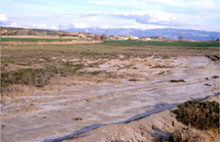SOIL DEGRADATION
Degradation implies a loss of current or potential soil use and a reduction in its potential functions. A given process may be natural, whereas if it is induced, intensified or accelerated by human action it may become a degradation process. For example, a saline ecosystem is a natural medium whose conservation may be of interest, while the salinization of an irrigated area must be considered a degradation process and is therefore undesirable
We are interested in degradation processes as these are the processes that have to envisaged and combated by soil protection measures within the framework of assuring the desired sustainable development. The potential effects of soil degradation must be taken into account when different actions are applied to the land.
Actions affecting the land
Promoting sustainable urban development, protecting landscapes, assigning land uses, carrying out public works, designing landscape architecture, and creating gardens and parks will all be done more efficiently if their starting point is a knowledge of soils; this will help to prevent degradation. Carrying out work in areas with degraded soils is always possible but implies greater investment and higher management costs.
In areas in which there is initially a soil cover with growing plants, it is important to remove, store and subsequently reuse the topsoil before embarking upon any action that would imply sealing the land. This will ensure a much more favourable medium for plant growth, with lower building and maintenance costs, and will enhance soil and water conservation.
Actions related to public works
Identifying areas with potential problems deriving from soil degradation (risk of degradation by erosion, silting up of reservoirs, erosion of drainage basin soils, flood hazards, etc.) or specific soil characteristics (iron corrosion, potential conduits of iron or concrete) is important for the working life of public works.
Actions associated with opencast mining
Rehabilitation work which does not reincorporate topsoil previously removed from the area (previous soil reserves from the target area) will make revegetation more expensive and threaten its success. This delays the reintegration of the area into the surrounding landscape and hinders the recovery of the functions foreseen for the soils.
Actions related to the agricultural sector
Growing crops on soils subject to degradation processes (erosion, salinization of irrigated areas, compaction, etc.) leads to a progressive reduction in productivity, with the same input producing progressively poorer harvests. More inputs will be needed in order to maintain production as the soil degrades. The increased use of agrochemical products may also have other undesired effects on the environment
Actions related to water
Water quality is affected by soil degradation (loss of the transformation function, filtration and soil storage). The vulnerability of shallow water tables is related to soil quality and its efficiency in performing certain environmental functions.
Actions related to environmental quality
The management of pig slurry, sewage and other types of waste may cause soil degradation and a loss of water quality if the carrying capacity of each soil unit and its resilience are not taken into account.
Soil degradation is associated with a loss of biodiversity, reductions in carbon storage capacity, a loss of environmental quality and desertification.
TYPES OF DEGRADATION AND METHODS OF PREVENTION AND CONTROL
Soil degradation may have several causes:
• DEGRADATION BY PARTICLE DISPLACEMENT
Loss of thickness of the upper soil layer due to:
EROSION
– splash erosion
– sheet or inter-rill erosion
– rill erosion
– gully erosion
– tunnel erosion
– erosion due to deforestation
– the elimination of soil and water conservation measures
– modifying the form of the land without removing topsoil
– wind erosion
• STRESS DEGRADATION
Associated with an increase in internal work, without any external signs in the short term.
CHEMICAL DETERIORATION
 – salinization associated with
– salinization associated with
irrigation
– sodification
– acidification
– nutrient imbalance
– gleization
– toxic substances
PHYSICAL DETERIORATION
– compaction
– waterlogging
– sealing and crusting
– structural degradation
|